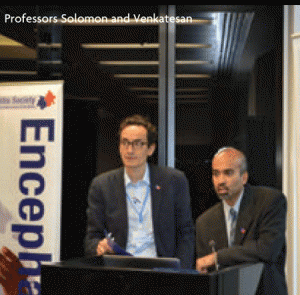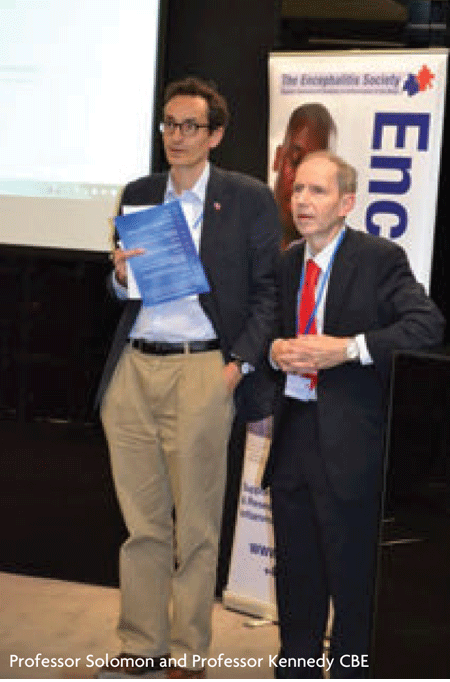
When the opportunity arose to come to this year’s Encephalitis Society Professional Seminar I was delighted to attend and brought along high expectations of increasing my knowledge base in an area of research and clinical practice that I am admittedly fairly new to.
A day of highly stimulating talks, packed with innovative research from across the globe highlighted the day’s theme of a wider community, endeavouring to share information relevant to best practice.

The seminar had a wide ranging audience allowing multi-disciplinary, service user and family perspectives to fuel lively post talk debates and questions. This diverse range of perspectives added to the quality of the day by offering what felt like extremely comprehensive discussions on thoroughly engaging topics.
The afternoon started with a very warm welcome from Dr Ava Easton CEO and Professor Tom Solomon, Chair of the Encephalitis Society Professional Panel. We were given an exciting sneak preview of the events the Society had planned for its 21st birthday celebrations next year; including a 21 day road-show visiting a different location in the country each day, raising awareness of Encephalitis and the work of The Society.
It was then time to kick off the talks, with Dr Arun Venkatesan from the John Hopkins University, presenting ‘Acute encephalitis: prognostic factors and novel therapies’. Dr Venkatesan highlighted factors that through his work in acute settings have shown to contribute to poor outcomes and how this might inform patient care during hospitalisation. The audience was given an overview of Encephalitis hospitalisation rates of 250,000 patients from the US dating between 2000-2010. Predictors of mortality within this data set suggest that there is a need to focus on the very young and old. Dr Venkatesan then honed in on factors identified through his work on patients admitted to the Johns Hopkins Hospital. Research showed that patients that had thrombocytopenia, cerebral oedema or status epilepticus were at a greater risk of death. The focus of the talk then went on to the question; what can we do as clinicians to further reduce these risk factors? Dr Venkatesan then put forward persuasive evidence to suggest that a ketogenic diet can be effectively used to treat status epilepticus in patients with encephalitis, and may also have a protective anti-inflammatory effect.
Next, Dr Jennifer Lemon, University of Liverpool presented a talk looking at how qualitative, semi-structured interviews with parents might be a useful tool in deciding which outcomes are important to measure in children. Dr Lemon highlighted the need for a core set of outcomes that help understand a condition that is complex and varied. The parent’s perspective of how outcomes change over time were shown to be a key theme. Transcripts with parents documented how the focus of concern shifts through the different stages of the illness. Initially they have concerns about mortality and impairments whilst their child is in acute care, then the focus moves to the impact of problems back in their child’s normal setting and anxieties about the future. Dr Lemon ended the talk by stating that there is currently a lack of standardisation of outcomes and previous encephalitis trials have focused more on impairments rather than the impact of problems on the child’s day to day life.
Dr Defres, also based at the University of Liverpool then followed with a talk titled ‘Understanding and improving the outcome of encephalitis’. Dr Defres explained that the aim of The EncephUK study was to determine the clinical predictors of encephalitis for a diagnostic tool for the junior doctor on the frontline. However, this is quite an undertaking given the knowledge of how tricky it can be to diagnose Encephalitis. But poor outcomes resulting from delays in recognising symptoms and starting treatment, dictate the need for this important research to be carried out and completed.
Dr Thomas Miller, University of Oxford, continued the afternoon seminar with a talk showing the research directions on patient related outcomes in VGKC limbic encephalitis. Describing memory as a ‘broad church’, Dr Miller introduced his work on creating ‘PROMS’ (Patient related outcome measures) as part of a multi-pronged approach that can drill down to patient problems. Dr Miller found using a questionnaire in combination with semi-structured interviews a useful way of picking up the social narrative that can be lost in a questionnaire alone. Dr Miller stated that PROMS are useful in explaining the ‘how & what’ people experience. Dr Miller’s talk was insightful in his opinion that a more holistic model of measuring patient experience can be used to better guide research and drug treatment targeting a more patient driven agenda.
After a short break it was then time for Professor Peter Kennedy CBE, Head of the Neurology department at Glasgow University, to deliver his highly anticipated keynote address on ‘Human African Trypanosomiasis (sleeping sickness) in sub-Saharan Africa’. One of only a handful of medical doctors working on the disease, he is the world’s leading expert on nervous system infection in sleeping sickness, and has spent much of his career devoted to raising awareness of sleeping sickness in Africa and beyond. His acclaimed popular science book on the topic ‘The Fatal Sleep’ has also been highly commended by the BMA and generates money for charities in Africa. Professor Kennedy introduced the audience to the historical context of a disease that currently puts 70 million people at risk of developing it in Africa. During the period 1894-99, the bite of the tsetse fly was discovered by Sir David Bruce to be the mode of transmission of the causative trypanosome parasites in animal Trypanosomiasis. Over the following decade different forms of trypanosomes, also transmitted by the tsetse fly, were shown to be the cause of Human African Trypanosomiasis (HAT), both forms occurring in sub-Saharan Africa. Professor Kennedy pointed out that recurrences and the periodic re-emergence of HAT have been due to several factors, in particular wars and socio-economic instability which lead to inadequate patient surveillance and vector control. Professor Kennedy then provided an overview of the current highly toxic drug treatment and promising drugs that are in the pipeline, whilst clearly pointing out the major challenges involved in treating an at-risk population living in some of the poorest rural areas of Africa. The talk was summed up by looking at how a better understanding of HAT pathogenesis, better disease staging and more effective drug therapy could improve both the control of the disease and the outlook of patients suffering from sleeping sickness.
In keeping with the global theme of the day, Dr Jay Selman then joined us via satellite from Blythedale Children’s Hospital, Valhalla, New York (USA). Dr Selman’s talk, ‘Outcome: Cohort of 15 children with anti-NMDA Receptor Encephalitis,’ presented the results of his research, the characterisation of anti-NMDA Receptor Encephalitis and a preliminary evaluation of the economic burden of the condition in the acute and rehabilitation settings. The research presented the clinical pathways of a cohort of consecutively-admitted patients from acute inpatient to inpatient rehabilitation to outpatient settings. Both tracheostomies and gastrostomy-tube were indicators of severity and more prolonged hospital stays. Although most of the patients did make some improvement, 25 – 40% were left with moderate to severe global deficits. Two thirds had moderately delayed language function and 71% had a change in mood. Having summarised the interventions and deficits in detail, Dr Selman’s closing point was that intensive rehabilitation is essential in many children with this disorder. Early and aggressive initial treatment improves the outcome. Dr. Selman is continuing to follow the outcome of this cohort. Dr. Selman closed the presentation with preliminary data on the estimated charges for the acute and rehabilitation hospitalisations in the cohort of 17 children; this totalled almost £4,000,000 or €4,900,000.
Dr Mike Griffiths & Dr Rachel Kneen, both Consultant Neurologists from Alder Hey Children’s hospital and researchers at the University of Liverpool, co-presented a talk on their work in Nepal. The joint talk outlined the work that they had been involved with in Nepal via the Institute of Infection and Global Health and with partners from Kanti Children’s hospital in Kathmandu. Dr Griffiths explained the type of viral encephalitis most common to the region, Japanese Encephalitis Virus (JEV). The virus is normally hosted by animals but due to the humid, rural and agricultural land, humans become accidental hosts. It is a condition that needs to be treated seriously as there are over 20k deaths annually resulting from JEV, leaving 20-50% with neurological impairments, epilepsy, behaviour, language and motor problems. He talked about the economic burden that encephalitis had on families there, which has one of the poorest countries in the world. Dr Kneen then expanded on one particular impairment; epilepsy. She talked about an exciting new project to provide paediatric epilepsy training courses in Nepal. Dr Kneen highlighted how epilepsy was a global health concern that warranted investigation in countries such as Nepal, where it is stigmatised and mortality rates are higher. From the findings of an initiative to start paediatric epilepsy training courses in Nepal, Dr Kneen showed that better awareness and good management can have a positive effect on outcomes.
Dr Sarosh Irani, a Consultant Neurologist from Oxford, spoke about the links between infectious and autoimmune forms of encephalitis and how it is important to understand the mechanisms of encephalitis and the optimal treatments for various forms of encephalitis. Sarosh described the role of autoantibodies in Japanese encephalitis (JE). There are clinical similarities between JE and autoantibody-mediated forms of encephalitis, especially NMDA Receptor -antibody encephalitis, given the prominent hypokinetic movement disorder, coma and few seizures. Sarosh and colleagues from Oxford found that from a cohort of patients with JE, around 70% had antibodies which target the surface of neurons. Following the time course of these antibodies in individual patients, suggested that they appear a few weeks after the clinical onset of JE and may be responsible for modifying the disease course. This study suggests the potential importance of immunomodulatory therapies in patients with JE, as has been suggested by several recent studies examining herpes simplex virus encephalitis.
The penultimate talk of the day came from last year’s essay winner Dr Katarzyna Bera with her short talk ‘Could pathogenic autoantibodies in autoimmune encephalitis cross-link neurology and psychiatry.’ Dr Bera described the body of evidence that suggested early intervention has shown to produce better outcomes, however we can only treat somebody once we know what the disease is. A better understanding of the autoantibodies that are present in anti-NMDA-receptor encephalitis can help spur early interventions. Patients with these autoantibody presentations are often initially seen by psychiatrists. The aim would be to have a joint understanding that would join expertise between psychiatry and neurology, finishing her talk with the quote ‘The mind is the living brain in action.’
The last scheduled talk of the afternoon came from last year’s essay prize runner-up Dr Satyasheel Ramful. His talk focused on predisposing genetic factors that make some patients more susceptible to developing Herpes Simplex virus-1. An understanding of newly identified toll-like receptor pathway deficits might ultimately result in more effective and targeted therapeutic agents for Herpes Simplex Encephalitis.
The conference concluded with a book signing of The Fatal Sleep by Professor Peter Kennedy, CBE and a cheese and wine reception.
Photos and videos of the 2014 presentations can be viewed here www.encephalitis.info
If you are interested in attending the 2015 seminar, please register to become an Encephalitis Society Professional member (free of charge) and you will automatically be notified of the details.
ACNR 2015;15(2):26-27. Online 26/06/15

